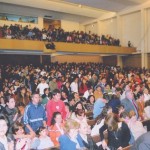Trigger warning: The following post contains frank descriptions of the hate speech against LGBTQ people that my church used to inculcate fear and contempt in its youth. It’s probably not something you want to read if you’re already having a bad day. I have decided to write about homophobia for two reasons: first, to demonstrate the falsity of fundamentalist rhetoric about “hating the sin and loving the sinner,” and, second, to shed light on the tools fundamentalists use to instill fear of LGBTQ people in their children.
I was raised to be homophobic. Oh, my church had lots of ways to deflect the label when it was applied to us, but deep down, I was afraid. The other kids were afraid, too. When pressed, we would spew lines like “hate the sin, love the sinner” or “I’m not afraid of gay people, I just disagree with their lifestyle.” (That one confuses me now: how can you “disagree” with someone else’s life? It’s not about disagreement, it’s about disapproval.) There’s always this old favorite, too: “They don’t even know they’re in sin; they’re deceived. We need to pray for them.” Thing is, all of this masks a genuine, visceral, inculcated fear. I wasn’t raised to have a vague, condescending, pious pity for LGBTQ people. I was raised to be violently afraid of them.
My carefully crafted fundamentalist fear didn’t survive high school. I didn’t have a gay best friend or suddenly notice my own attraction to women. I didn’t “kiss a girl and like it,” which is how fundamentalists imagine lesbians are “made.” As with most major worldview transformations, mine came about by recognizing my own struggles in others’ lives and empathizing with them. The homophobic ideas I was taught didn’t stand up to the test of actually listening to LGBTQ people talking about their experiences (or, as it were, reading their words online). I don’t claim any kind of moral superiority for having “beat” my homophobic background; no one should be taught those things in the first place. I speak for three reasons: to expose the soft language evangelical-fundamentalists use to disguise a brutal fear and hatred, to encourage conservative Christians to examine their beliefs and reactions to LGBTQ people, and to throw my support behind everyone who bucks gender norms in one way or another.
In Part One, I’ll look at the way Christian fundamentalism constructs an aesthetic that is supposed to represent non-gender-normative people. In Part Two, I’ll examine the subtle and not-so-subtle rhetoric and body language fundamentalists use to express their opinions about homosexuality. In Part Three, finally, I’ll discuss the way I found my way out of that matrix of beliefs and became a supporter of LGBTQ rights (otherwise known as human rights).
At the end of this series, I hope to put together another, broader series about how people who have left fundamentalist Christianity have negotiated their beliefs about sexuality (their own or others’). Following the format of Libby Anne’s Raised Quiverfull project, I plan to gather a variety of responses that tell the story of how individuals absorbed, deflected, negotiated or rejected messages about sexuality before and after leaving fundamentalism. If you’d like to be part of this project, please email me at [email protected].
















